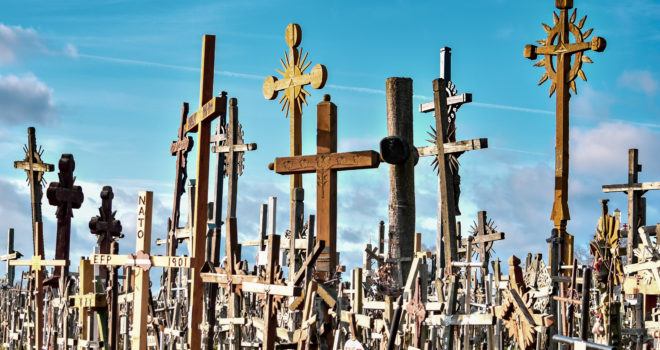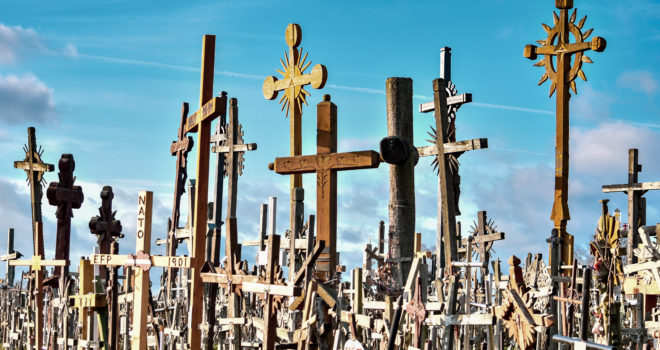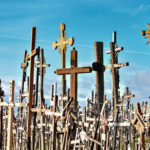Near the town of Šiauliai, over a hundred thousand crosses stand erect on a hill top. It is referred to as Kryžių Kalnas, or the “Hill of Crosses.” Pilgrims come and plant crosses in the ground to carry on the tradition. Notes of dedication and gratitude are expressed. Prayers of thanksgiving are offered for the mercy of God is unfathomable, and the original Christians who made their faith known on the hill are hailed as heroes. All who visit the hill — pilgrims and tourists alike — are invited to marvel in wonder that a simple cross was once the bane of Soviet soldiers, while being the saving grace of the Lithuanians.
Under Soviet occupation (1940-1991) in the Baltic country of Lithuania, the Lithuanian language was outlawed. Practicing your religion was forbidden. In fact, the churches were closed. The reality was bleak.
The situation escalated as persecution worsened. Lithuanians and Poles were sent to gulags, families torn apart, and all hope seemed to fade. The Lithuanian people could have chosen to respond in desperation. Instead, they displayed their opposition.
The geo-political situation set the stage for an uprising, not one with words, rather, with a symbol. A symbol made from a tree, originally designed as the most torturous killing machine in the Roman Empire: The Cross.
When the Soviets believed there was nothing left of human freedom, the persecuted began placing crosses, large and small, on a country hill to show their defiance. Soon, the hill was covered in not only crosses, but a variety of religious symbols: crucifixes, images, statues and rosaries.
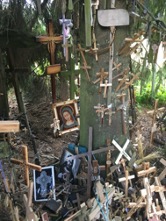
The country hill near the Lithuanian town of Šiauliai became a sore point for the Soviets. According to the Hill of Crosses website, the Soviet government destroyed over 5000 crosses in 1961 by breaking, burning, and burying the crosses. In contrast, the hill was the pride of the persecuted. The Soviets thought they had dampened their Faith, but they only strengthened their resolve. The resilience of the Lithuanians was unmatched as more religious symbols appeared.
The Soviets, bothered by the act of rebellion, initiated extreme measures and bulldozed the religious display several times. Orders were sent to patrol the area and guard the hill from additional contraband. Much to their bewilderment and dismay, crosses multiplied, reflecting the life-giving omnipotence of the Almighty. Evidently, the image of the cross has power beyond its physical reality. Why? Because our Lord transcends this world. The mystery continues to unfold in our greatest treasure of the Church: the prayer of the Holy Mass and the miracle of the Blessed Sacrament of the Altar. The Lithuanian people’s display reminds us that we were not made for this world; we are created for Eternal Glory.
Our Catholic Faith can never be extinguished as long as we choose to embrace our human inclination to praise our Creator. The Hill became a Shrine, a means of paying homage to the King of Kings. This image particularly strikes a chord as an unlikely component, Legos, configure a cross that proudly represents the greatest love story. The Lego Cross tells the story of defying the odds as Soviet soldiers outnumber village populations and Soviets attempt to outlaw human creativity. While it is probable that the Lego cross was a recent edition, it does not make it any less thought-provoking.
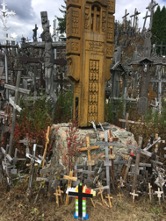
The Lithuanians demonstrate that it may not always be easy to live our Faith. When the churches close by human authority, the interior castle is fortified, exhibited by this simple country hill. Now, the Hill of Crosses is beloved by the Lithuanians and Poles, and known throughout the world as a major pilgrimage site. One of the beautiful fruits of this testament to the faith of the Lithuanian and Polish people was a visit by Pope St. John Paul II in 1993.
Human risk, courage, defiance, rebellion, freedom, and virtue are all encapsulated in the story of the Hill of Crosses. Not only is it a testament to the Lithuanian people’s perseverance, it conveys they were fighting for a higher power. We all inherently know that we are designed for infinite glory, therefore no man can limit our rights. Freedom of speech, for example, exists as our tongues are on loan from God and we are given the great responsibility to use them to preach truth. If we fail in that capacity, or governing powers attempt to limit man from praising our Savior, Judgement Day will be a rude awakening. Fortunately, our God is merciful and patient with us. If we live in the present moment and make offerings every day, we may have the joy of seeing the Beatific Vision. The brave soul who first placed a cross on the hill is surely enveloped in glory. For take courage as the Lithuanians declare, the battle has already been won.
✠


